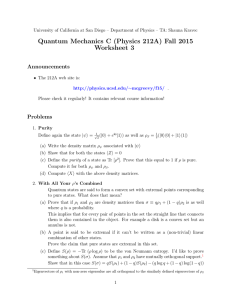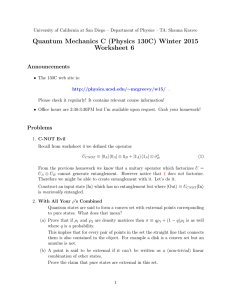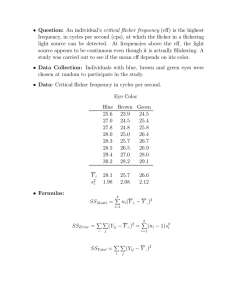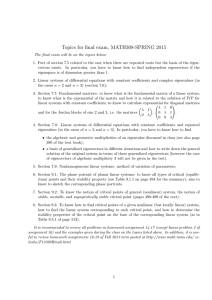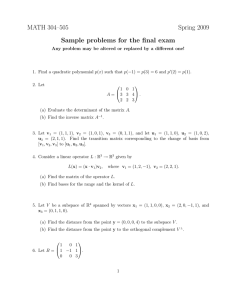Quantum Mechanics C (Physics 212A) Fall 2015 Worksheet 3 – Solutions
advertisement
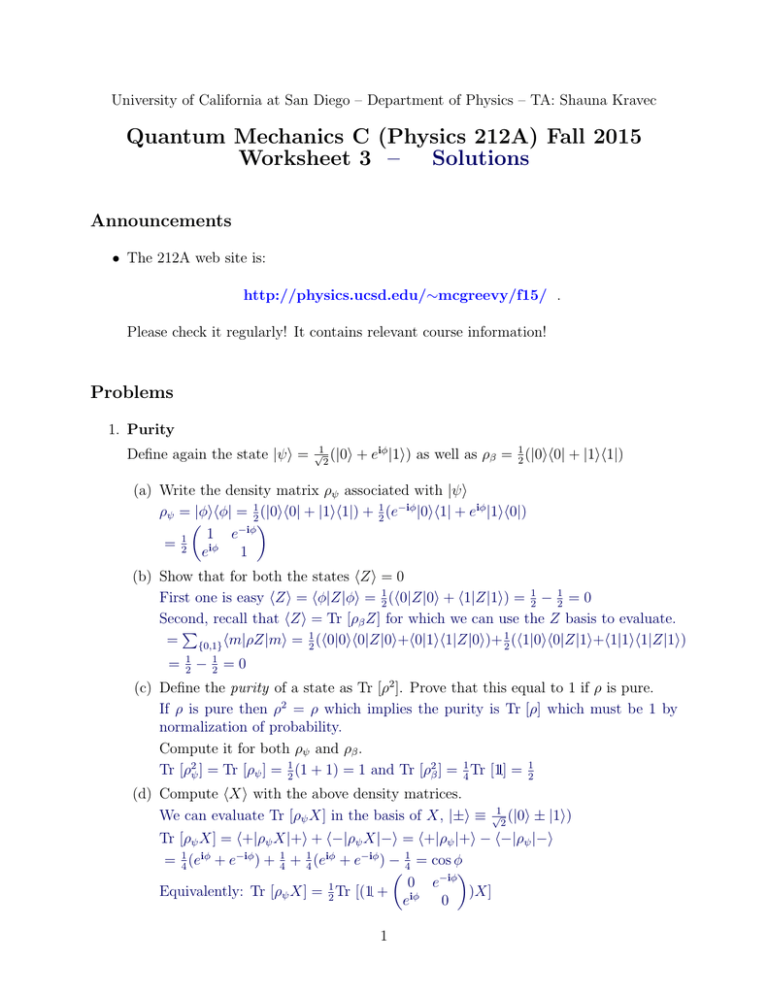
University of California at San Diego – Department of Physics – TA: Shauna Kravec
Quantum Mechanics C (Physics 212A) Fall 2015
Worksheet 3 –
Solutions
Announcements
• The 212A web site is:
http://physics.ucsd.edu/∼mcgreevy/f15/ .
Please check it regularly! It contains relevant course information!
Problems
1. Purity
Define again the state |ψi =
√1 (|0i
2
+ eiφ |1i) as well as ρβ = 12 (|0ih0| + |1ih1|)
(a) Write the density matrix ρψ associated with |ψi
ρψ = |φihφ| = 21 (|0ih0| + |1ih1|) + 21 (e−iφ |0ih1| + eiφ |1ih0|)
−iφ
1
e
= 21 iφ
e
1
(b) Show that for both the states hZi = 0
First one is easy hZi = hφ|Z|φi = 12 (h0|Z|0i + h1|Z|1i) = 21 − 12 = 0
Second, recall that hZi = Tr [ρβ Z] for which we can use the Z basis to evaluate.
P
= {0,1} hm|ρZ|mi = 12 (h0|0ih0|Z|0i+h0|1ih1|Z|0i)+ 21 (h1|0ih0|Z|1i+h1|1ih1|Z|1i)
=
1
2
−
1
2
=0
(c) Define the purity of a state as Tr [ρ2 ]. Prove that this equal to 1 if ρ is pure.
If ρ is pure then ρ2 = ρ which implies the purity is Tr [ρ] which must be 1 by
normalization of probability.
Compute it for both ρψ and ρβ .
Tr [ρ2ψ ] = Tr [ρψ ] = 21 (1 + 1) = 1 and Tr [ρ2β ] = 14 Tr [1] = 12
(d) Compute hXi with the above density matrices.
We can evaluate Tr [ρψ X] in the basis of X, |±i ≡
√1 (|0i
2
± |1i)
Tr [ρψ X] = h+|ρψ X|+i + h−|ρψ X|−i = h+|ρψ |+i − h−|ρψ |−i
= 41 (eiφ + e−iφ ) + 14 + 14 (eiφ + e−iφ ) − 41 = cos φ
0 e−iφ
1
Equivalently: Tr [ρψ X] = 2 Tr [(1 + iφ
)X]
e
0
1
iφ
e
0
=
[X] +
[
] = 0 + cos φ
0 e−iφ
Tr [ρβ X] = 12 Tr [1X] = 0
1
Tr
2
1
Tr
2
2. With All Your ρ’s Combined
Quantum states are said to form a convex set with extremal points corresponding
to pure states. What does that mean?
(a) Prove that if ρ1 and ρ2 are density matrices then σ ≡ qρ1 + (1 − q)ρ2 is as well
where q is a probability.
This implies that for every pair of points in the set the straight line that connects
them is also contained in the object. For example a disk is a convex set but an
annulus is not.
We require σ = σ † , which is true by inspection, and both Tr [σ] = 1 and that
there are no negative eigenvalues
Tr [σ] = qTr [ρ1 ] + (1 − q)Tr [ρ2 ] = q + (1 − q) = 1
The sum of two hermitian positive matrices is still positive, even if they don’t
commute. Therefore there cannot be negative eigenvalues.
(b) A point is said to be extremal if it can’t be written as a (non-trivial) linear
combination of other states.
Prove the claim that pure states are extremal in this set.
P
P
Consider a state ρ and its spectral decomposition ρ = i pi |ψi ihψi | with i pi = 1
If this decomposition, itself a linear combination, is to be trivial then it only
includes a single term: ρ = |ψihψ| which is pure
(c) Define S(ρ) = −Tr (ρ log ρ) to be the von Neumann entropy. I’d like to prove
something about S(σ). Assume that ρ1 and ρ2 have mutually orthogonal support.1
Show that in this case S(σ) = qS(ρ1 ) + (1 − q)S(ρ2 ) − (q log q + (1 − q) log(1 − q))
P (2)
P (1)
Let ρ1 = i pi |iihi| and ρ2 = j pj |jihj| where no coefficients are zero and
hi|ji = 0 for all i, j. This implies ρ2 |ii = 0 and similar for ρ1
(2)
(1)
Therefore σ|ii = qpi |ii and σ|ji = (1 − q)pj |ji allowing me to diagonalize σ.
P
P (1)
(1) P
(2)
(2)
This implies −S(σ) = λσ log λσ = i qpi log qpi + j (1−q)pj log(1−q)pj
P (1)
P
(1)
(2)
(2)
= i qpi log pi + j (1 − q)pj log pj + q log q + (1 − q) log(1 − q)
=⇒ S(σ) = qS(ρ1 ) + (1 − q)S(ρ2 ) − (q log q + (1 − q) log(1 − q)) where I’ve used
P (1)
P (2)
p
=
1
=
i
i
j pj in splitting the logs.
3. C-NOT Evil
Consider the following operator
UCN OT ≡ |0A ih0A | ⊗ 1 B + |1A ih1A | ⊗ σBx
(1)
Notice that (1) does not factorize as U = UA ⊗ UB . Therefore we might be able to
create entanglement with it.
1
Eigenvectors of ρ1 with non-zero eigenvalue are all orthogonal to the similarly defined eigenvectors of ρ2
2
(a) Write a matrix representation of (1) in
1 0 0
0 1 0
1B 0
=
|0A ih0A | ⊗ 1 B =
0 0 0
0 0
0 0 0
0 0 0
0 0
0 0 0
|1A ih1A | ⊗ σBx =
=
0 0 0
0 σBx
0 0 1
1 0
0 1
Thus combined gives UCN OT =
0 0
0 0
the computational basis
0
0
0
0
0
0
1
0
0 0
0 0
0 1
1 0
(b) What are the eigenvectors of (1)? Are any entangled?
|0 ↑i and |0 ↓i obviously are. Diagonalizing the lower right submatrix like a Pauli
X the remaining two eigenvectors are |±i = √12 (|1 ↑i ± |1 ↓i).
Note none of the eigenvectors above is entangled. However the eigenspace is
degenerate! Therefore at least some linear combinations in that space will be
entangled.
(c) Construct an input state |Ini which has no entanglement but where |Outi ≡
UCN OT |Ini is maximally entangled.
The most general form of a product state is |Ini = (a0 |0i + a1 |1i) ⊗ (b0 | ↑i + b1 | ↓i)
|Outi = UCN OT |Ini = |0A ih0A | ⊗ 1 B |Ini + |1A ih1A | ⊗ σBx |Ini
= a0 |0i ⊗ (b0 | ↑i + b1 | ↓i) + a1 |1i ⊗ (b0 | ↓i + b1 | ↑i)
which if you set b0 = 0, b1 = 1 and a0 = √12 = a1 you get a Bell state
3
